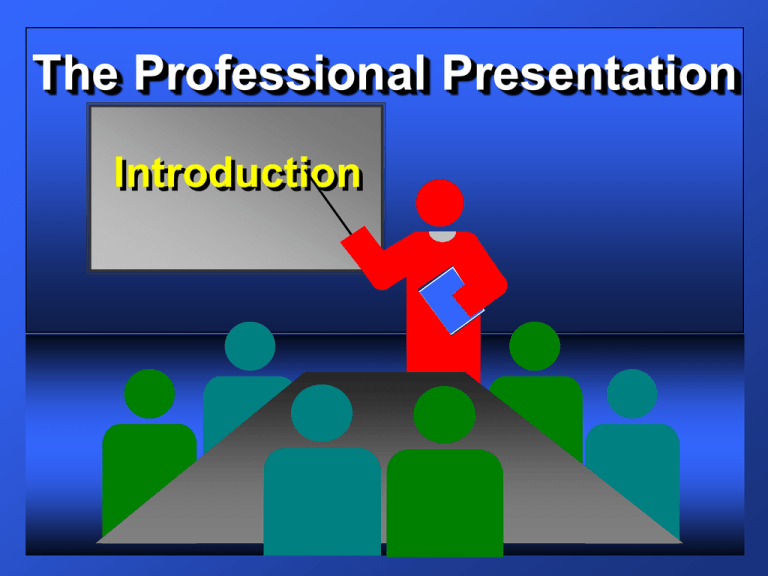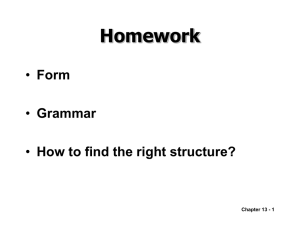04pres - Management Class
advertisement

The Professional Presentation Introduction Professional Presentations Introduction • • • • Definitions Role of the Presentation Presentation Skills Systematic Planning Professional Presentations The Professional Presentation – “the public speech of the future.” • • • • • • • A MULTIMEDIA speech form Carefully planned, prepared, rehearsed, and evaluated Definite purpose, specified audience Audience size 5 to 30 to hundreds Authorized and assigned by a supervisor Not given by a professional speaker Often given repeatedly Borman & Borman, Speech Communication: An Interpersonal Approach Professional Presentations Role of Presentations • • • • • Making Contacts Communicating Ideas and Information Persuading Reporting Advancing Your Career Professional Presentations Presentation Skills • Knowing the Information • Planning • Designing and Producing • Preparing • Delivery • Assessment Professional Presentations Systematic Planning • Purpose: to control the nature and quality of presentation development (system) • Content: the ideas, materials, facilities, and techniques used in the process (system) • Process: interactions among the elements of the system How subject matter relates to the script to the photographer to the slides to the auditorium to the rehersal to the projectionist to the follow-up questions to program changes. Professional Presentations Solving Communication Problems • IDENTIFY NEED: What is vs. what should be. • IDENTIFY PROBLEM: What is missing that causes the need? • IDENTIFY SOLUTION OPTIONS: What alternatives are there? PowerPoint Presentations–Examples Only You Can Prevent Forest Fires United States Forest Service 1996 Keep Titles Large and Use Graphics Where Appropriate PowerPoint Presentations–Examples Only You Can Prevent Forest Fires United States Forest Service 1996 Make Good Use of the Available Space PowerPoint Presentations–Examples Only You Can Prevent Forest Fires United States Forest Service 1996 Differentiate the Importance of Messages PowerPoint Presentations–Examples Presentation Evaluation • Verbal Presentation • Visual Presentation • Content Organization • Overall Considerations Bullet Slide: Use a title and make clear points. PowerPoint Presentations–Examples Presentation Evaluation • Verbal Presentation • Visual Presentation • Content Organization • Overall Considerations Bullet Slide: Use “Build” to Develop Your Points PowerPoint Presentations–Examples Presentation Evaluation • Verbal Presentation • Visual Presentation • Content Organization • Overall Considerations Bullet Slide: Use a Graphic Element to Visually Illustrate PowerPoint Presentations–Examples Presentation Evaluation • Quality of Verbal Presentation • • • • • Voice quality (nervous/controlled) Projection of voice to audience Flow of presentation (what was next?) Verbalization (did s/he use “um” “ya know” “ahh”?) Visual Presentation • • • • Size of letters (could you read everything?) Use of colors (dark background, light letters) Use of pictures/clip art (did some slides have pictures?) Spacing (were some slides too crowded or too empty?) Bullet Slide: Limit the Amount of Verbal Information PowerPoint Presentations–Examples Presentation Evaluation • Verbal Presentation • Visual Presentation • Content Organization • Overall Considerations Don’t Use Confusing Backgrounds. PowerPoint Presentations–Examples Presentation Evaluation • Verbal Presentation • Visual Presentation • Content Organization • Overall Considerations Don’t Use Too Many Colors or Fonts PowerPoint Presentations–Examples Presentation Evaluation • • • • Verbal Presentation Visual Presentation Content Organization Overall Considerations Keep It Simple!!!!!









